Why you can trust Tom's Hardware
Comparison Products
We’re putting the Red SN700 4TB up against other 4TB drives, but also two 2TB drives. For the latter, we’ve selected the SN750 because it’s so similar in design and also the IronWolf 525, which is also a NAS-oriented drive. Some of the 4TB drives are QLC-based and others are TLC-based so we get a full picture of what’s available at high capacities.
Trace Testing - 3DMark Storage Benchmark
Built for gamers, 3DMark’s Storage Benchmark focuses on real-world gaming performance. Each round in this benchmark stresses storage based on gaming activities including loading games, saving progress, installing game files and recording gameplay video streams.

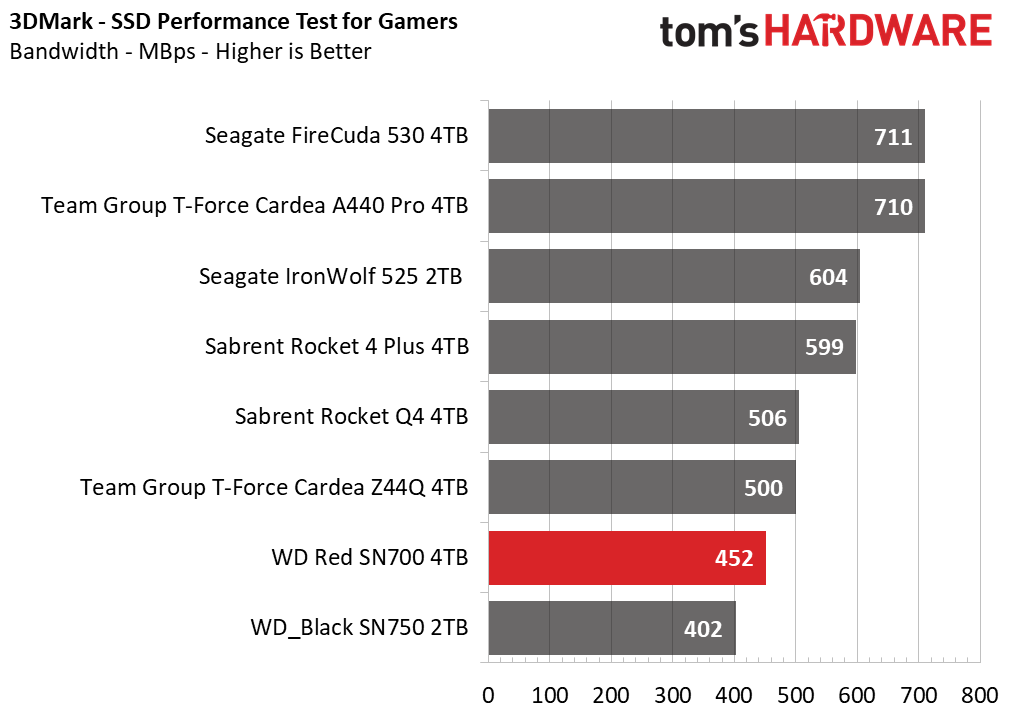
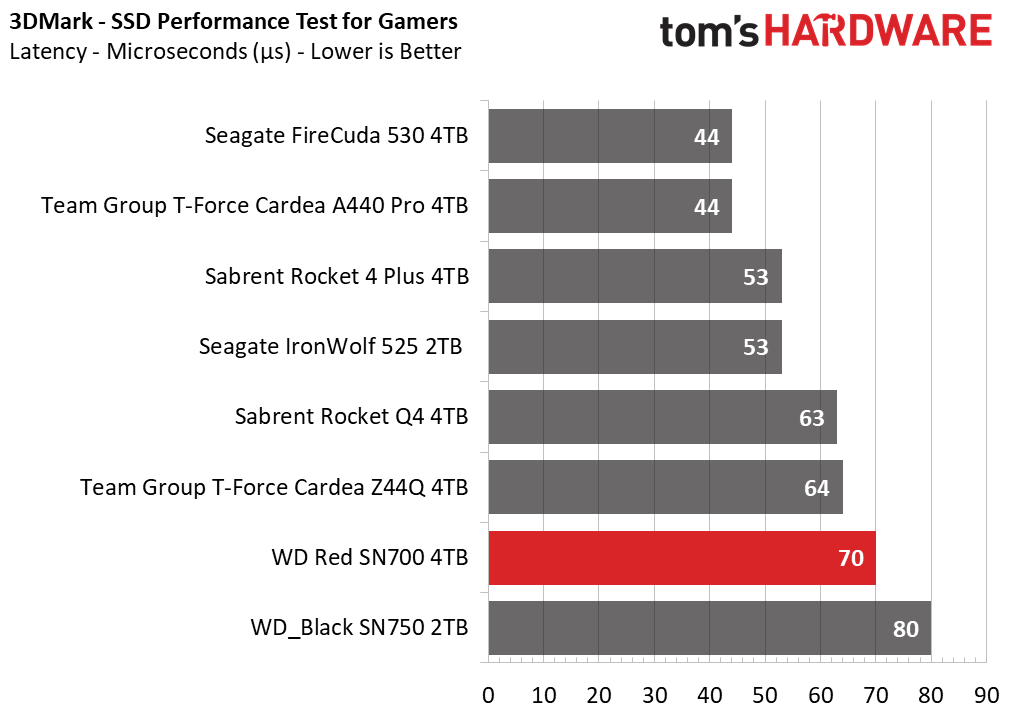
It should be no surprise that the SN700 gives weak results here, given that the WD Black base is relatively outdated. However, it beats the SN750, largely thanks to the updated controller and flash. This drive is not oriented at gamers, but it would still get the job done if you’re buying it to use as a large, dedicated games drive. In fact, it could be very nicely used as a Steam drive, including with future DirectStorage support.
Trace Testing – PCMark 10 Storage Benchmark
PCMark 10 is a trace-based benchmark that uses a wide-ranging set of real-world traces from popular applications and everyday tasks to measure the performance of storage devices.
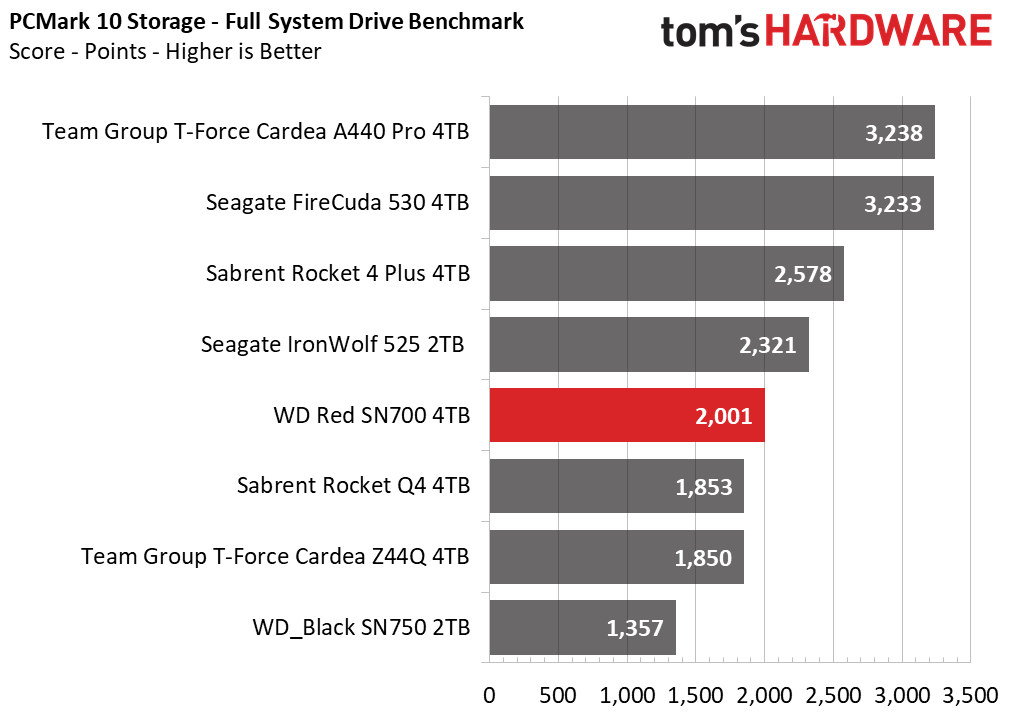
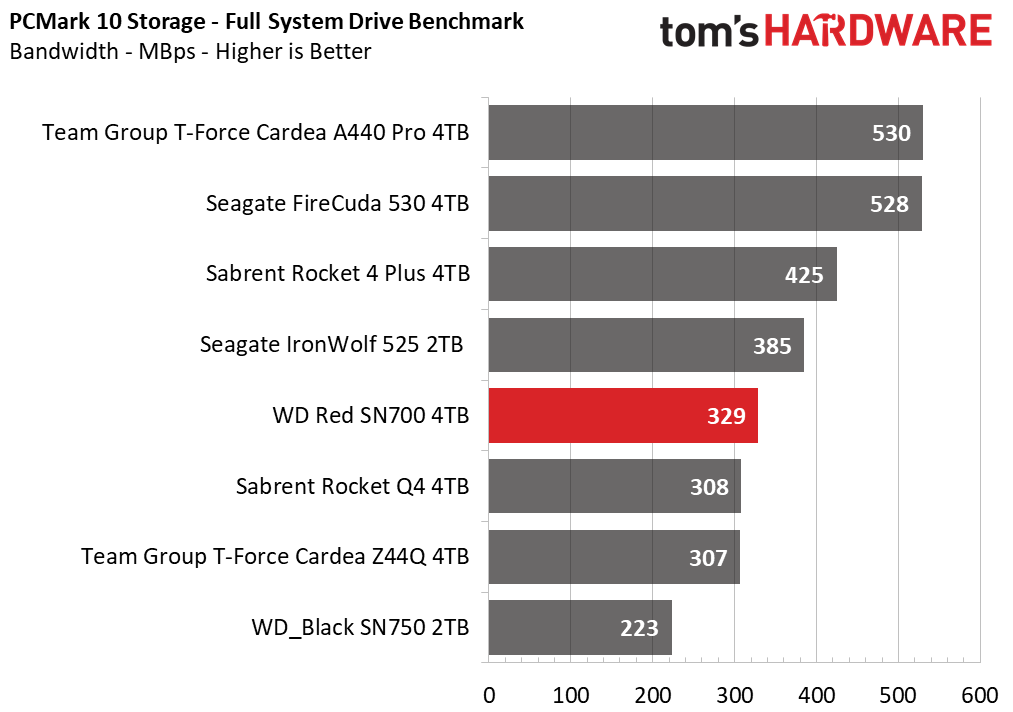

The Red SN700 does better here, which isn't surprising. The larger SLC cache and newer, faster flash help it easily overcome the older Black SN750. The 96-Layer BiCS4 is faster per die in native or TLC mode than 64-Layer BiCS3, plus the drive's static SLC cache is larger due to the Red SN700 having a higher capacity. Thanks to its TLC flash, the drive also beats the two QLC-based drives in the lineup.
Transfer Rates – DiskBench
We use the DiskBench storage benchmarking tool to test file transfer performance with a custom, 50GB dataset. We copy 31,227 files of various types, such as pictures, PDFs, and videos to a new folder and then follow-up with a reading test of a newly-written 6.5GB zip file.
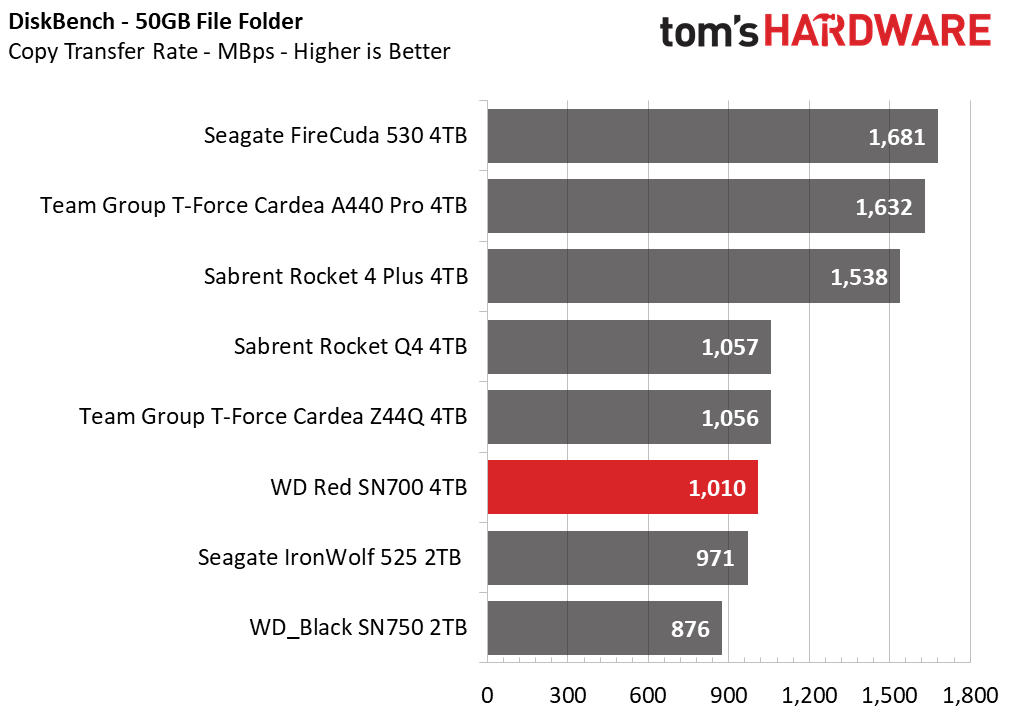

Nothing surprising here, as the Red SN700 beats the Black SN750 in the copy test thanks to its larger cache but falls behind the other drives in the read transfer rate test. It also keeps up with the QLC- and E16-based drives during our file copying test.
It’s worth underlining the fact that the competition utilizes PCIe 4.0 controllers — in this case, the Phison E16 or E18. That gives a distinct advantage to these drives in many benchmarks, particularly ones that emphasize burst rather than sustained performance.
Get Tom's Hardware's best news and in-depth reviews, straight to your inbox.
Synthetic Testing - ATTO / CrystalDiskMark
ATTO and CrystalDiskMark (CDM) are free and easy-to-use storage benchmarking tools that SSD vendors commonly use to assign performance specifications to their products. Both of these tools give us insight into how each device handles different file sizes.
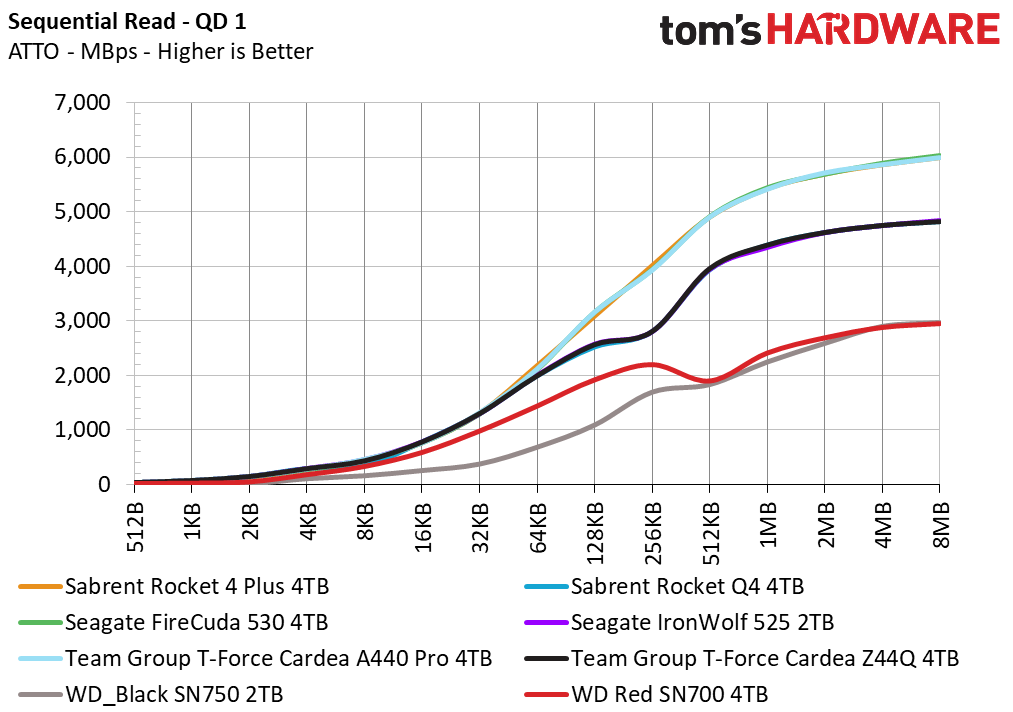
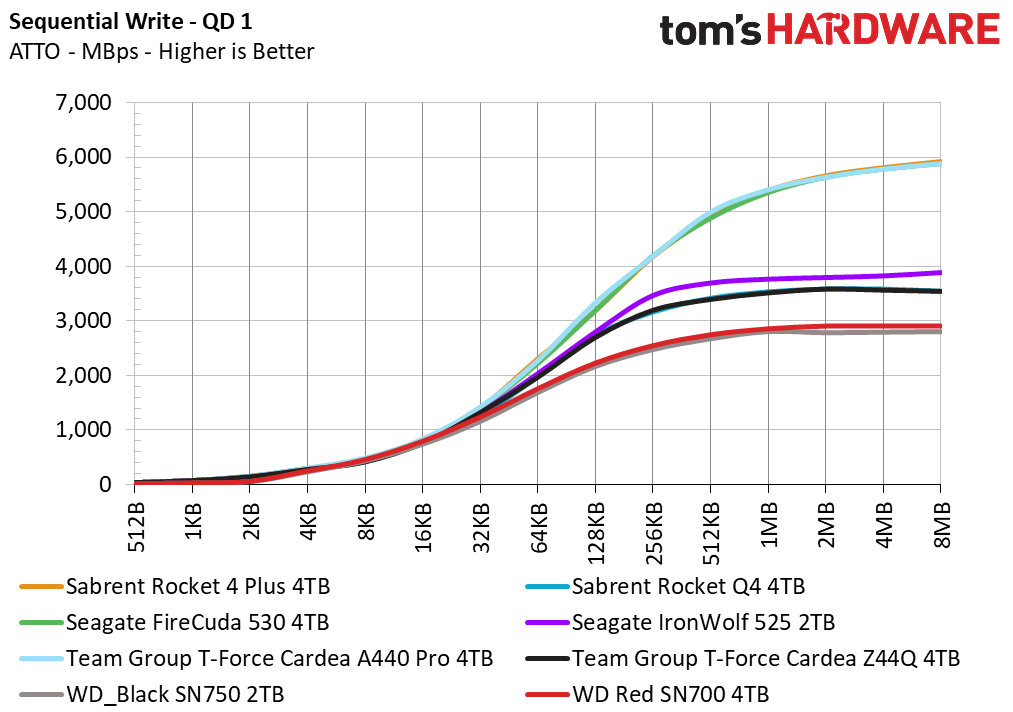
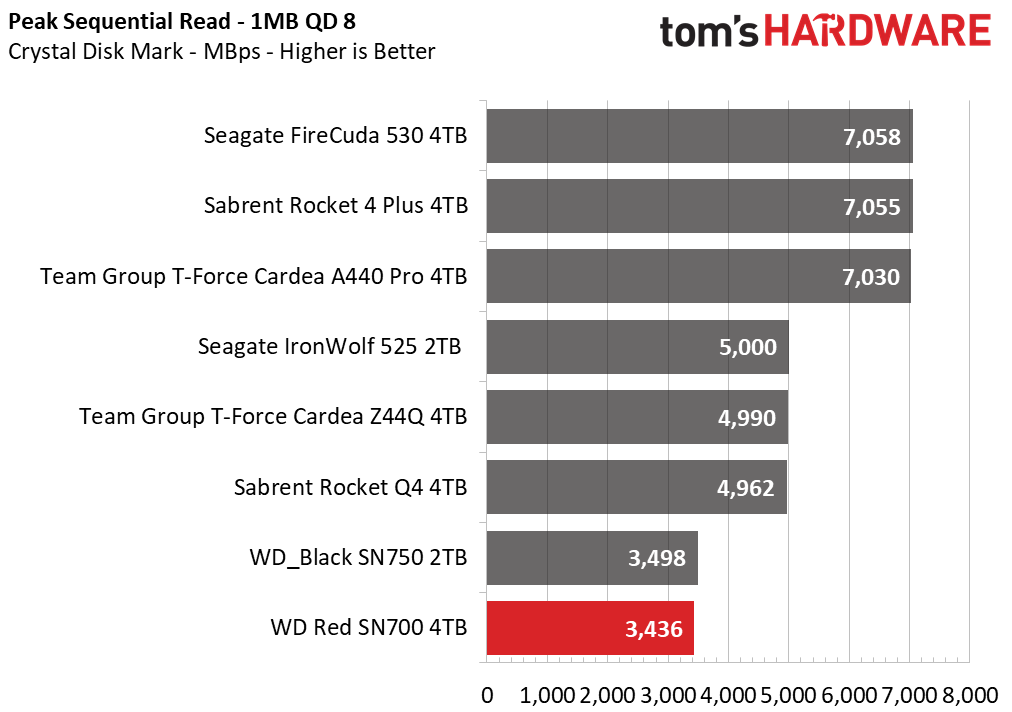
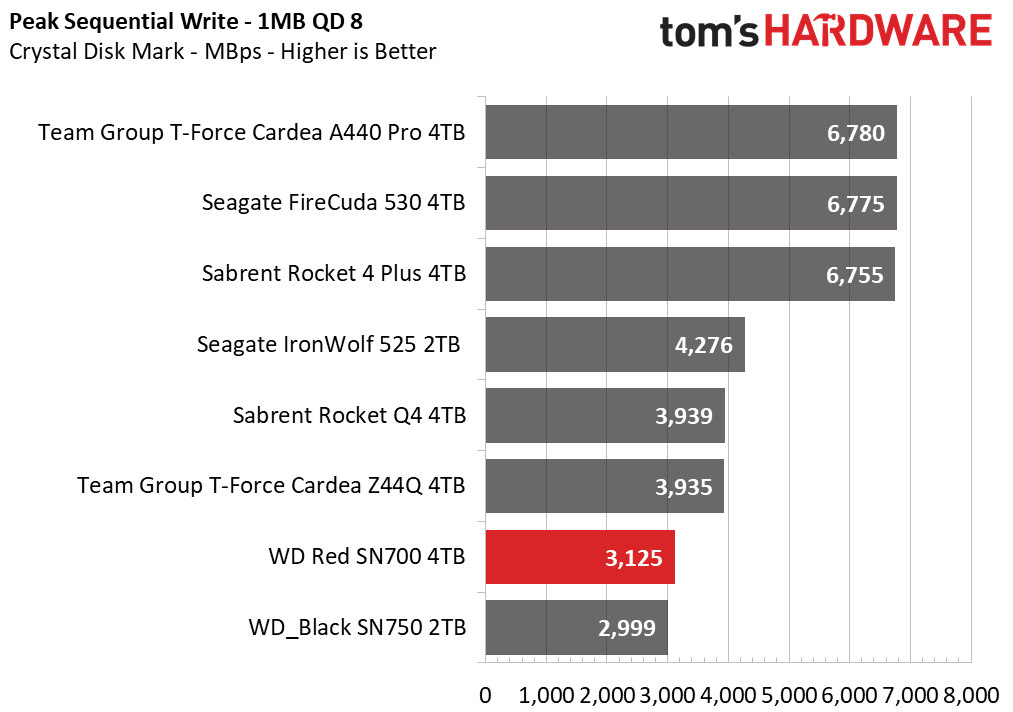
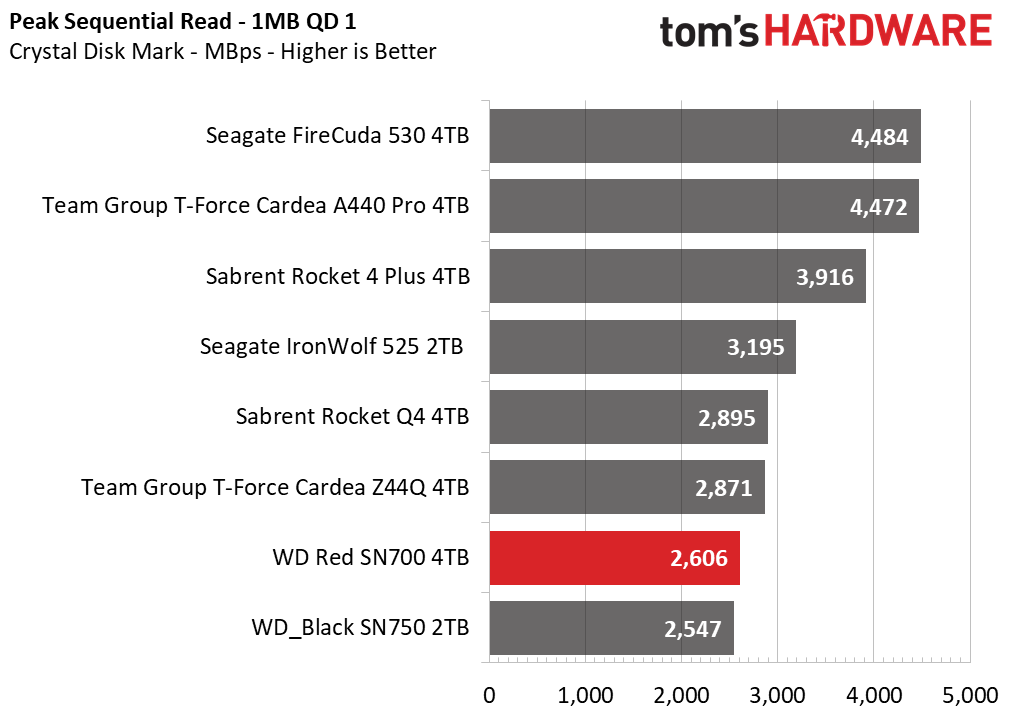
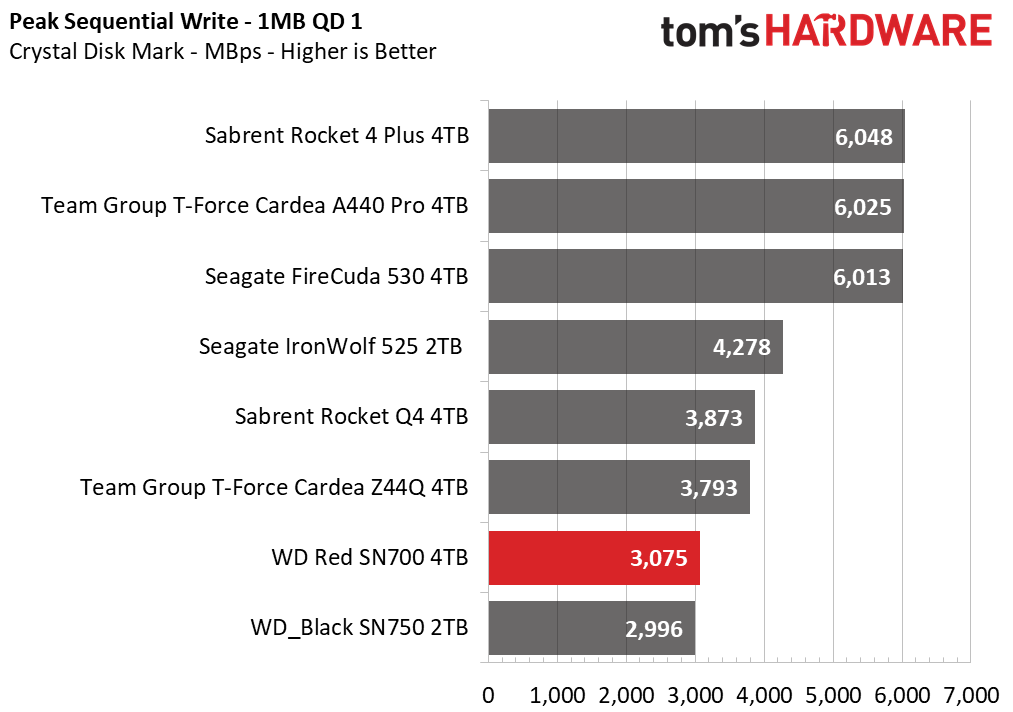
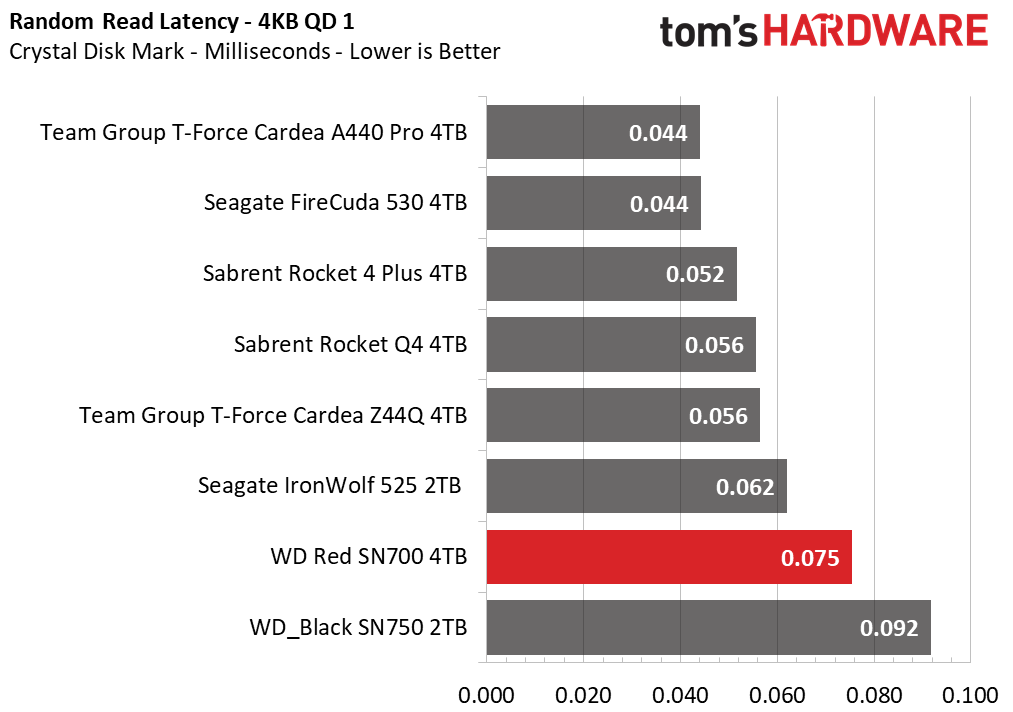

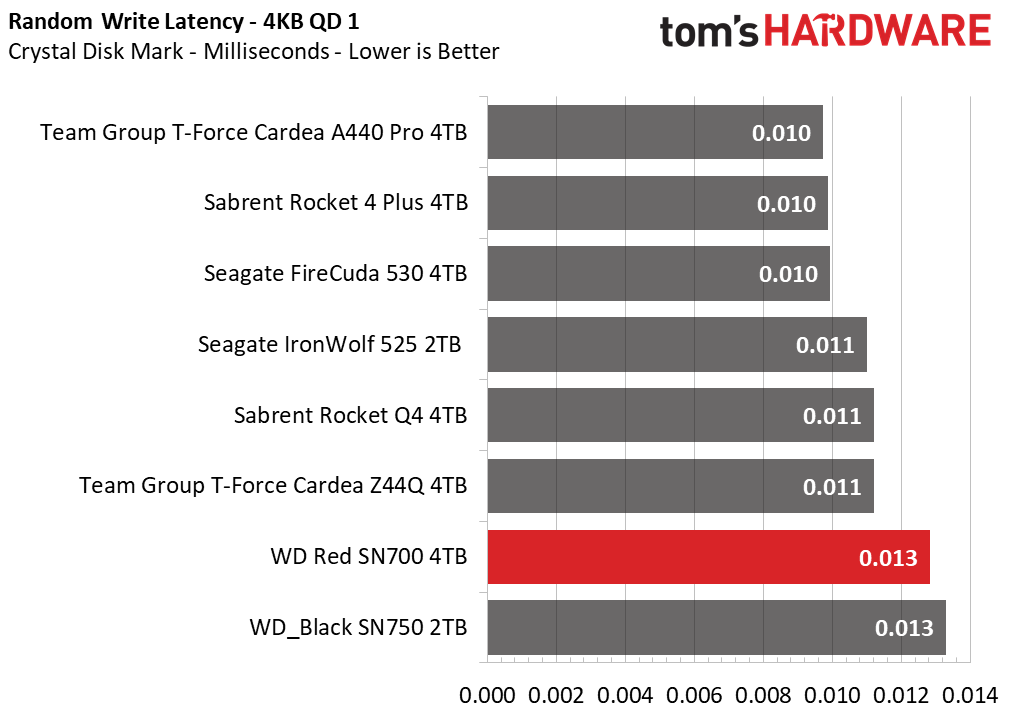

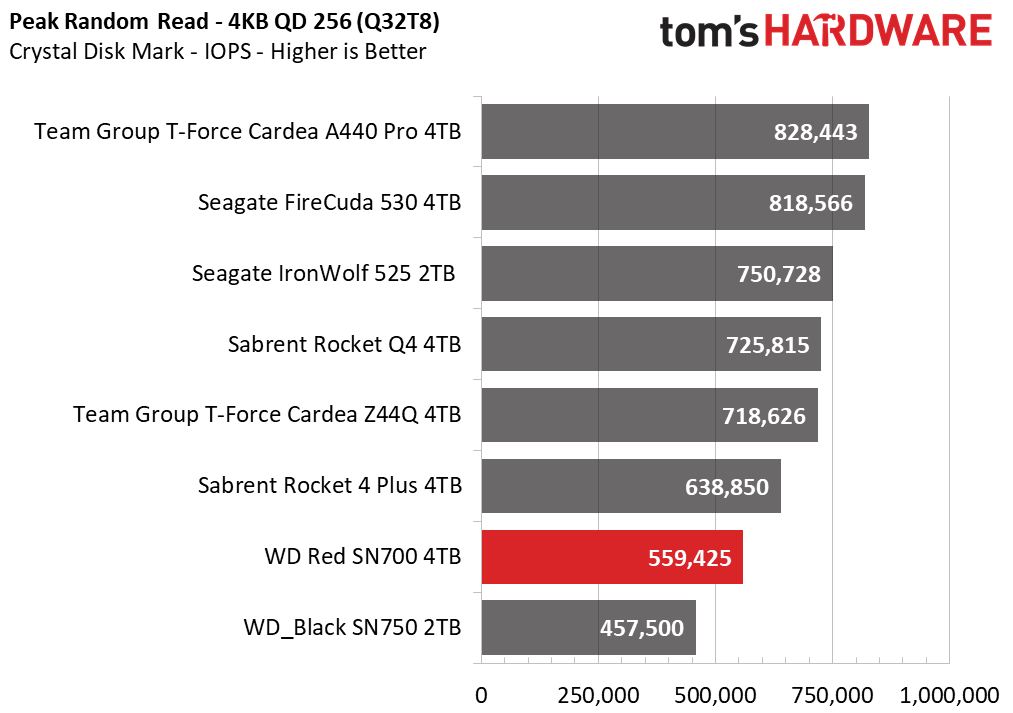
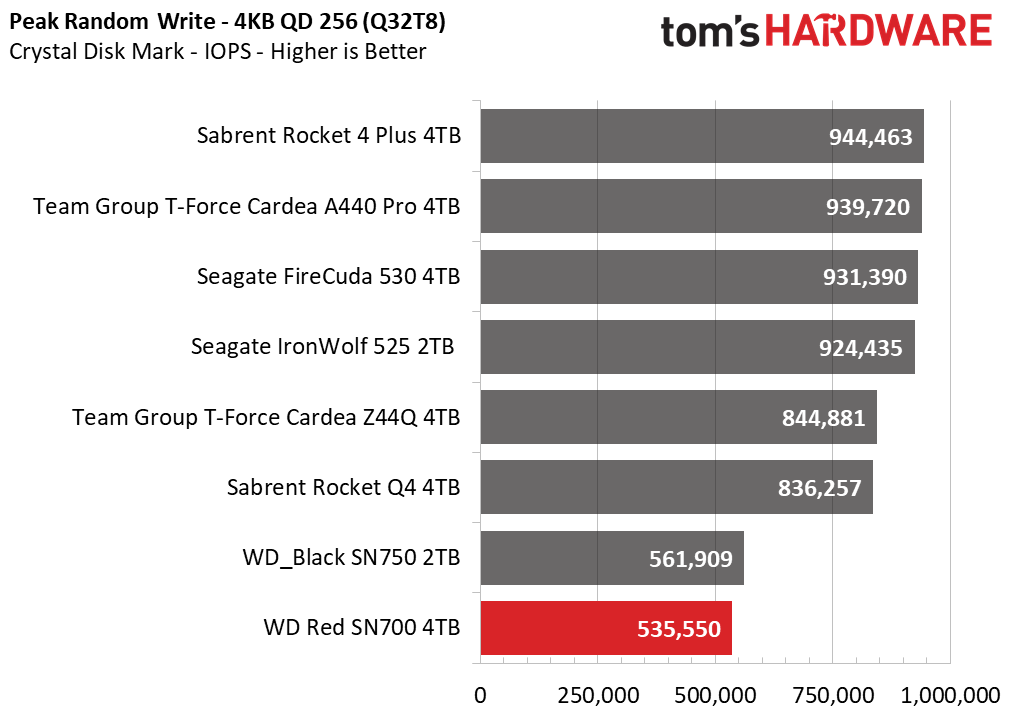
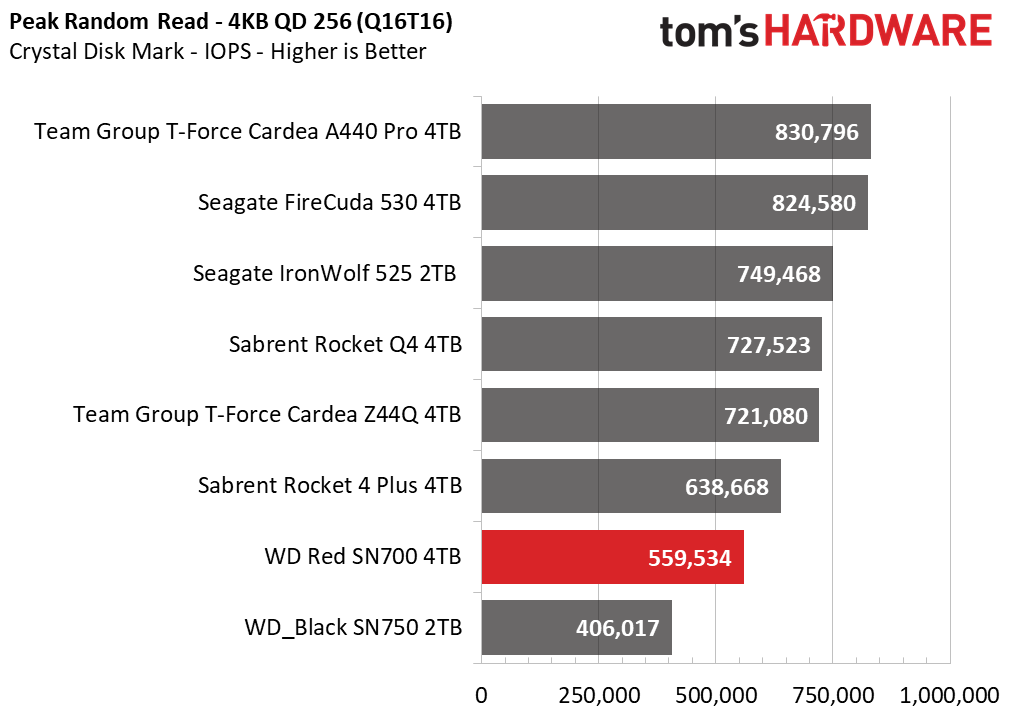
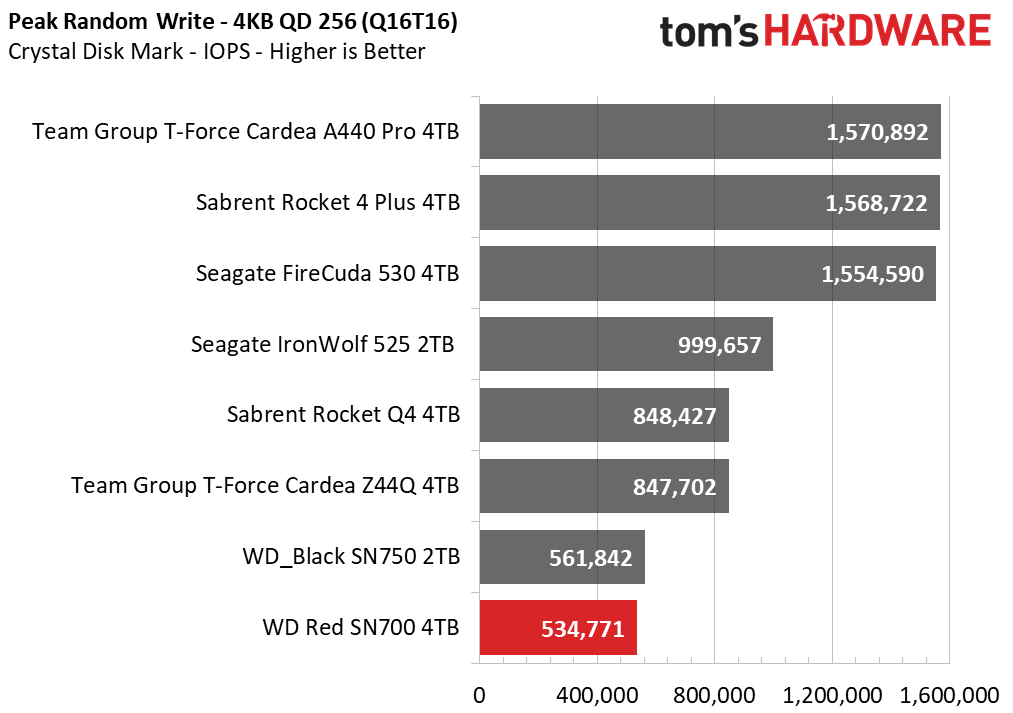
Th\e Red SN700 matches or beats its sibling, the Black SN750, but falls behind the rest of the pack with larger I/O requests. It’s worth noting that smaller I/O, particularly 4KB, tends to be a desirable target at low queue depths. Many NAS workloads may actually achieve higher queue depths depending on usage.
With CrystalDiskMark, we see the PCIe 3.0 sequential performance limitations, although the Red SN700 does edge out the Black SN750. In addition, latency and IOPS fall behind the competition, likely because the controller isn’t as powerful and has a lower I/O transfer rate, although the drive generally outperforms the Black SN750.
Sustained Write Performance and Cache Recovery
Official write specifications are only part of the performance picture. Most SSDs implement a write cache, which is a fast area of (usually) pseudo-SLC programmed flash that absorbs incoming data. Sustained write speeds can suffer tremendously once the workload spills outside of the cache and into the "native" TLC or QLC flash. We use Iometer to hammer the SSD with sequential writes for 15 minutes to measure both the size of the write cache and performance after the cache is saturated. We also monitor cache recovery via multiple idle rounds.
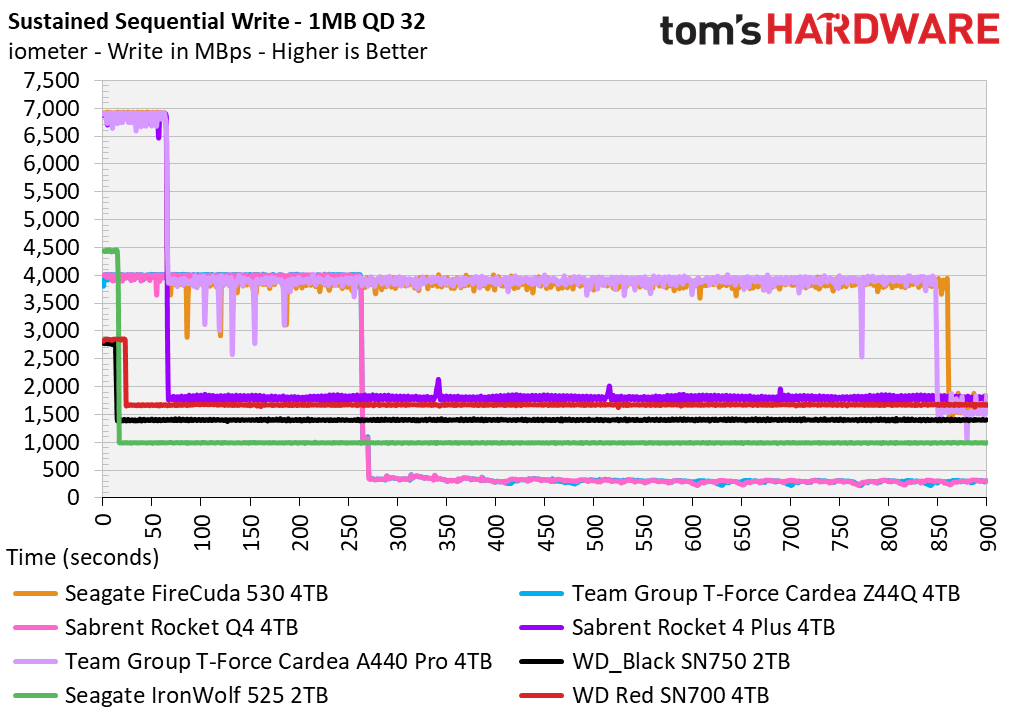

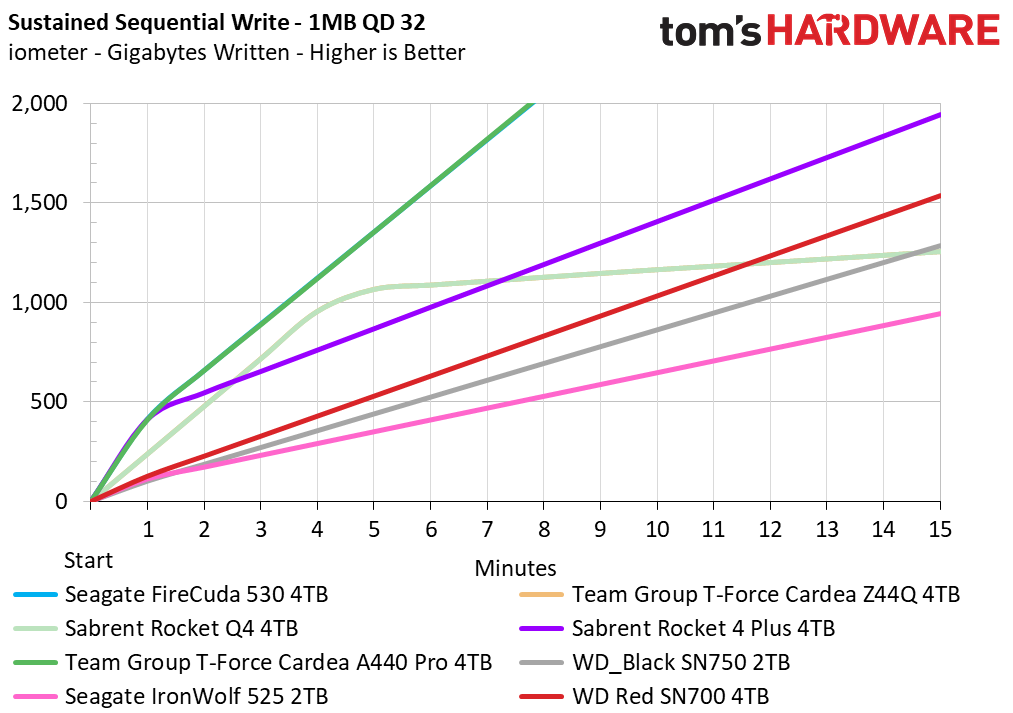

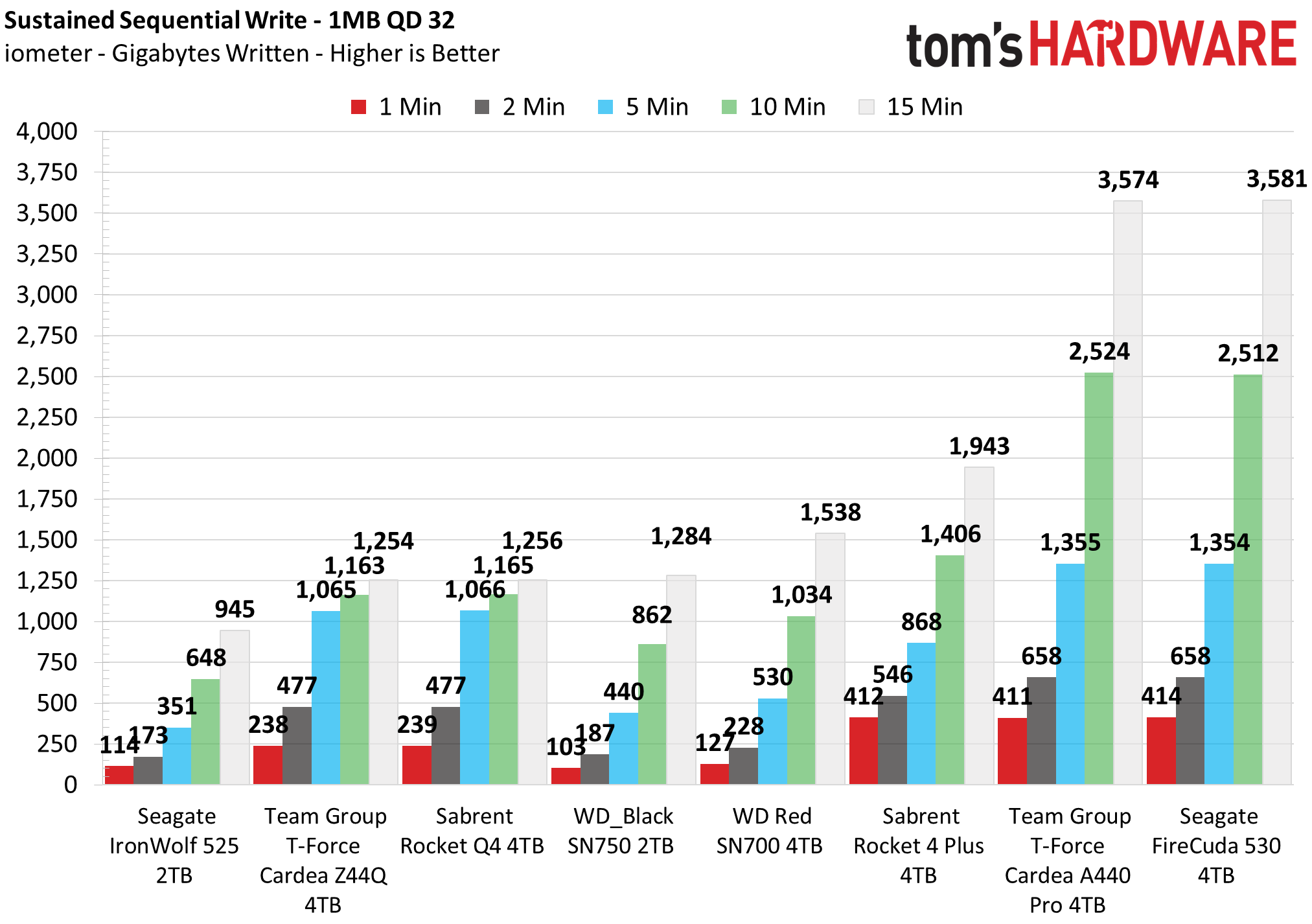
The Red SN700 does as expected here, given its hardware: fast writes to a limited, static SLC cache followed by consistent but high speeds in the direct-to-TLC mode. Notably, the cache is larger than the 2TB Black SN750, but the TLC sequential write speed is also faster, illustrating the performance bump of BiCS4 over BiCS3 flash. This is one type of workload that might more commonly be seen in enterprise workloads and also NAS, where consistency is king.
Typically, sustained writes are ignored in consumer SSD reviews because retail drives are designed around staying in SLC mode for writes, but that doesn’t necessarily apply to workspace drives. Additionally, it’s worth mentioning that reads more often come from the native flash, and overall steady state read/write performance is contingent on the cache design as well as the controller and flash. This is best illustrated when comparing this drive to the IronWolf 525.
Here the Red SN700 out-writes all but the E18-based drives, being particularly out-matched by ones utilizing Micron’s newer 176-Layer TLC. It handily defeats the IronWolf 525 and the QLC-based drives, plus shows its superiority over the Black SN750. This test only reveals one piece of the steady-state performance puzzle as consistency with latency is particularly important with heavier NAS use; however that is reflected here to some extent as it is unlikely a drive of this caliber will hit enough IOPS to meaningfully fall behind the PCIe 4.0 drives. This drive might also typically be mirrored, improving read performance in some cases.
This is, in fact, a good example of why enterprise drives usually lack SLC caching and, further, why static SLC can be beneficial. This type of pseudo-SLC — since it’s not real SLC but rather the native flash acting in a single-bit mode — has its own wear zone, which includes garbage collection. This ensures it is outside user space and also often uses the best flash within a given die. The result is that the drive does not have to worry about background folding or spikes in performance during the direct-to-NAND writing phase, or for that matter, be concerned about a copyback bottleneck phase. The result is higher performance consistency that is particularly useful in NAS usage, which is why the IronWolf 525 looks so different when compared to consumer E16-based solutions.
Most consumer drives utilize dynamic SLC or, more recently, a hybrid design with both static and dynamic. The former provides better burst performance while the latter offers the best of both worlds. It’s nevertheless worthwhile to distinguish between the types as there are actually significant differences, but for the purposes of the review, it’s simpler to say the Red SN700’s design works well with many intended NAS workloads. In addition, it’s worth mentioning here that the static cache in the Red SN700 recovers immediately during our idle period, which means smaller bursts of writes will be handled adroitly.
Power Consumption and Temperature
We use the Quarch HD Programmable Power Module to gain a deeper understanding of power characteristics. Idle power consumption is an important aspect to consider, especially if you're looking for a laptop upgrade as even the best ultrabooks can have mediocre storage.
Some SSDs can consume watts of power at idle while better-suited ones sip just milliwatts. Average workload power consumption and max consumption are two other aspects of power consumption, but performance-per-watt is more important. A drive might consume more power during any given workload, but accomplishing a task faster allows the drive to drop into an idle state more quickly, ultimately saving energy.
We also monitor the drive’s temperature via the S.M.A.R.T. data and an IR thermometer to see when (or if) thermal throttling kicks in and how it impacts performance. Remember that results will vary based on the workload and ambient air temperature.
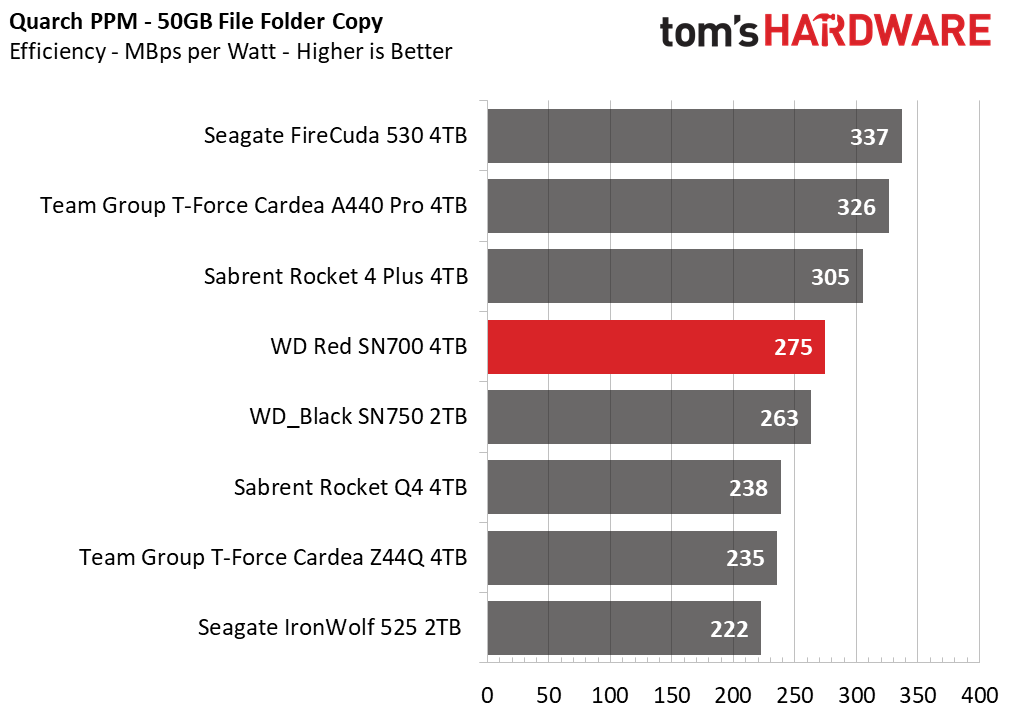
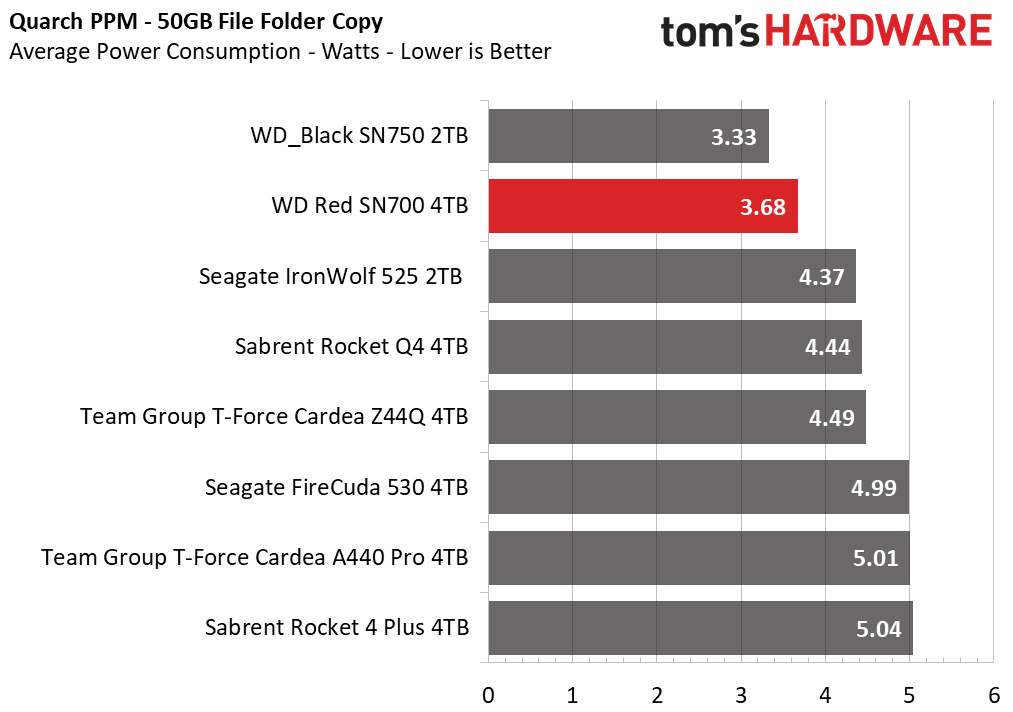
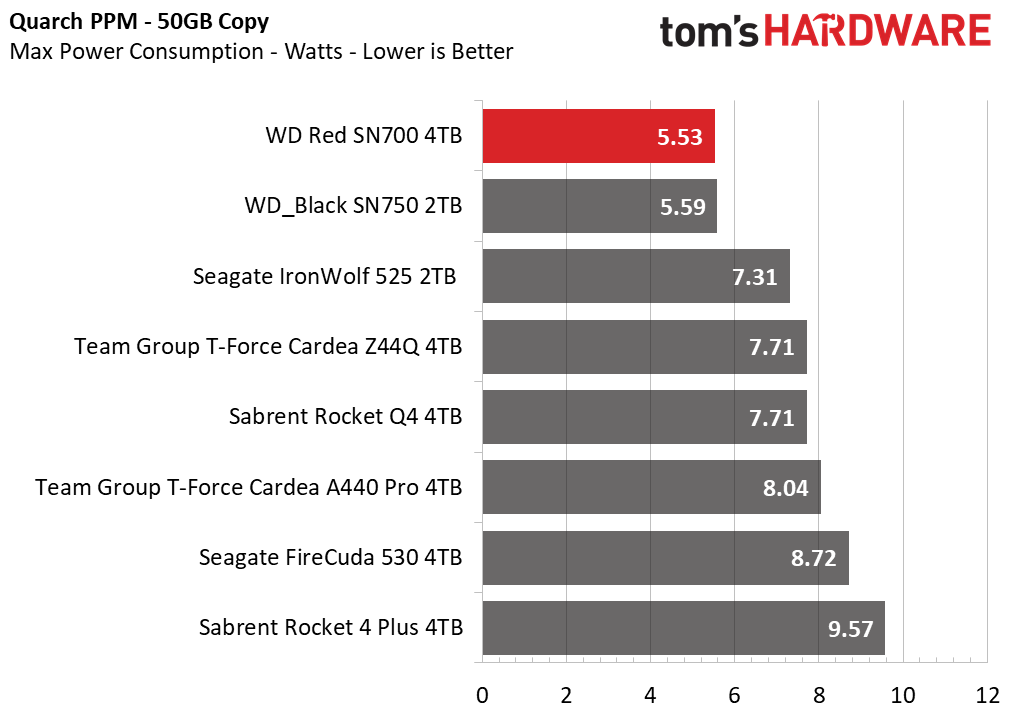

The Black SN750, when released, was a fairly efficient drive, so it is not surprising that the Red SN700 does well here. The Red SN700 has higher average power consumption, likely due to the larger SLC cache (SLC mode draws more power), but ultimately, it’s more efficient as it finishes faster, including in the post-SLC TLC mode. Max power consumption is the same between the two drives and is the lowest listed, keeping in mind that BiCS3 and BiCS4 are both 1.8V and that the other drives are PCIe 4.0 with higher peak throughput. We see the best idle results from the 176-layer drives.
In our experience, this drive did run hot under both idle and load conditions. As with most drives, there is a critical throttling point in the 83-85C range, and we were able to hit this with significant sustained writes, but performance remained good even in this state. The need for proper drive cooling is a facet of enterprise drives and, in this case, NAS if you are anticipating sufficient load.
Test Bench and Testing Notes
| CPU | Intel Core i9-11900K |
| Motherboard | ASRock Z590 Taichi |
| Memory | 2x8GB Kingston HyperX Predator DDR4 5333 |
| Graphics | Intel UHD Graphics 750 |
| CPU Cooling | Alphacool Eissturm Hurricane Copper 45 3x140mm |
| Case | Streacom BC1 Open Benchtable |
| Power Supply | Corsair SF750 Platinum |
| OS Storage | WD_Black SN850 2TB |
| Operating System | Windows 10 Pro 64-bit 20H2 |
We use a Rocket Lake platform with most background applications such as indexing, windows updates, and anti-virus disabled in the OS to reduce run-to-run variability. Each SSD is prefilled to 50% capacity and tested as a secondary device. Unless noted, we use active cooling for all SSDs.
Conclusion
It may appear unusual to readers that a drive like the Red SN700 would get good marks from us after a slew of benchmarks results that appear disappointing. On the contrary, this review illustrates that synthetic benchmarks can be limiting and that you need to know your intended workload to gauge an SSD properly. Further, performance is only one factor — price and capacity can often be more compelling. Different tests, including those that push edge cases like steady state with a fuller drive, would be more revealing.
PCIe 4.0 drives promise higher burst bandwidth, and QLC-based drives offer higher capacity, the latter hopefully at a lower cost. However, what if you need that capacity at a good price with consistent performance? What if PCIe 3.0 is good enough since you’re not impressed by pure SLC or sequential performance? Certainly, the Phison E16 and E18 controllers are powerful, but the height of their IOPS performance may be unrealistic for most workloads. As a reasonable counterpoint, consumer workloads love QD1 with small I/O, usually 4KB. However, this type of metric is often limited by the memory technology, including flash architecture and generation. This is to say that the Red SN700 might pass the “good enough” threshold on its weaker metrics for that type of usage.
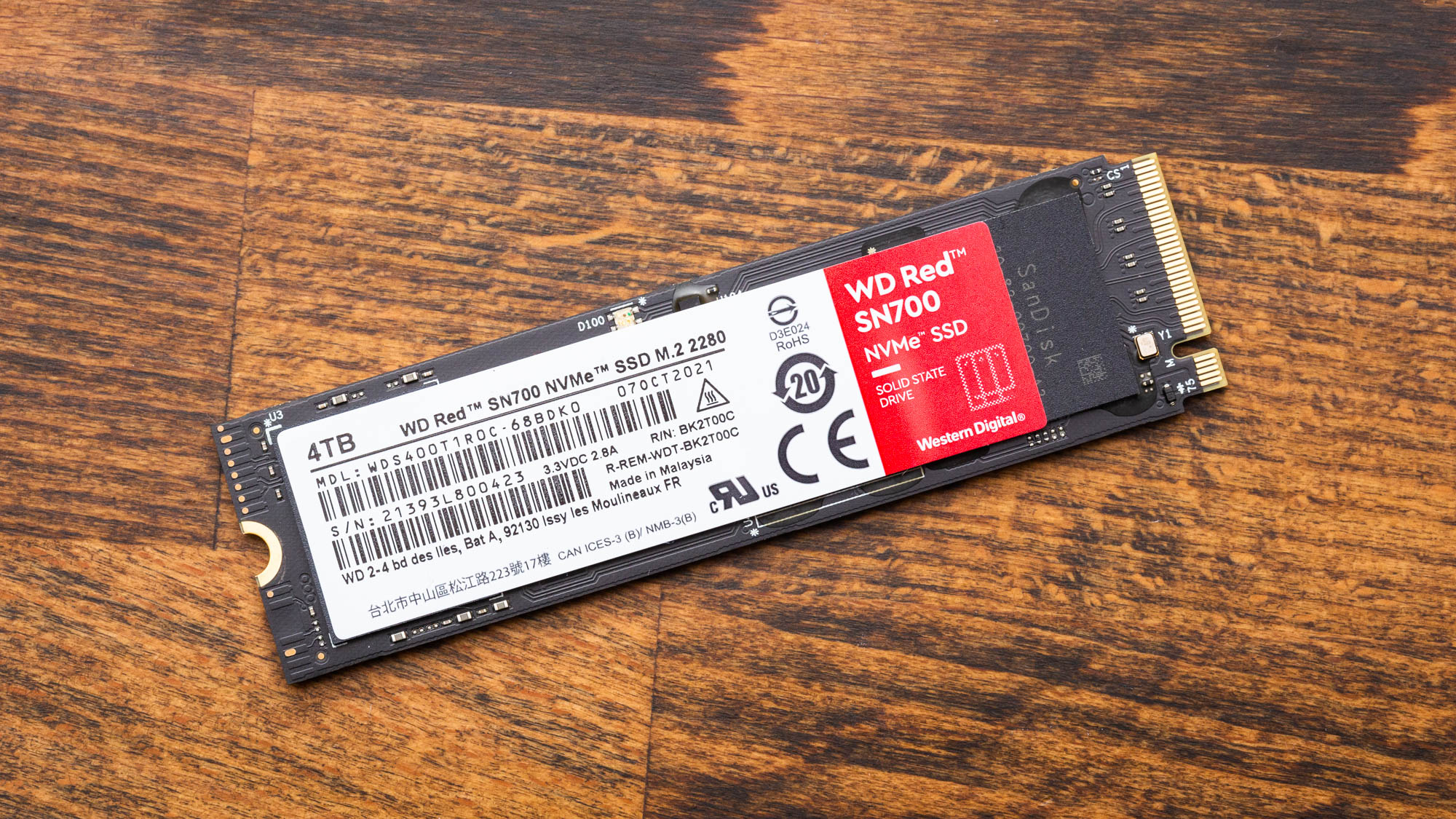
All of this is to say that the Red SN700 impresses despite itself. It takes all of the strong elements from the Black SN750 and improves upon them. This means efficiency and very strong steady state performance, including sustained writes. Consistency is assured due to conservative, static SLC caching. This is particularly relevant with NAS workloads, as detailed by WD. We see similar efforts made with SATA NAS drives, E12-based NAS drives, and of course the IronWolf 525. What makes the Red SN700 stand apart is its availability and price, considering you can get a 4TB TLC-based drive.
This is not a drive to set records. It’s also not meant to be an entry-level, “just enough” SSD like many DRAM-less options we have tested. It’s not meant to be awesome but rather reliable, if uninteresting. There are other 4TB TLC drives, but they tend to be priced far higher, like the Sabrent Rocket, or have a history of mixed hardware, like the Team MP34. Even with that consideration, this drive would likely offer an equivalent experience for consumer use.
We can’t give this drive high marks for the general user. For NAS use, however, it has few peers in this space, although PCIe 4.0 and even 5.0 options loom on the horizon — albeit while requiring updated NAS hardware. The PCIe 3.0 interface is older technology, but it gets the job done. Plus, who doesn’t want a 4TB NVMe game drive?
Note that Western Digital and Kioxia have been hit by contamination in their flash fabrication facility which has led to a notable fall in expected flash output. This has led WD to expect price increases amid a stock shortage. This means the SN700 may not be in ready supply as it has been or, if it is, the price might be raised. This does have an impact on the review and rating because the most attractive feature was an affordable 4TB SKU.
MORE: Best SSDs
MORE: How We Test HDDs And SSDs
MORE: All SSD Content

Shane Downing is a Freelance Reviewer for Tom’s Hardware US, covering consumer storage hardware.
-
escksu I would say the performance is pretty good. "incredible" Performance of those PCIE-4.0 drives are mostly on synthetic benchmarks only, mainly on sequential read/write.Reply -
drajitsh This is a reality interesting drive for the consumer market/price.Reply
But you have not written about the tcg support